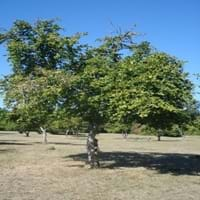Life Span
Perennial
Perennial
Type
Bulb or Corm or Tuber
Shrub, Tree
Origin
South America
Europe, Northern Africa, Western Asia
Types
Pamianthe cardenasii , Pamianthe parviflora , Pamianthe peruviana
Common Hazel, Asian Hazel, Beaked Hazel
Number of Varieties
Not Available
Habitat
All sorts of environments
Deciduous forests, Terrestrial
USDA Hardiness Zone
8-10
4-8
Sunset Zone
21,22
2a, 2b, 3a, 3b, 4, 5, 6, 7, 8, 9, 14, 15, 16, 17, 18, 19, 20
Habit
Clump-Forming
Oval or Rounded
Flower Color
White
Yellow
Flower Color Modifier
Bicolor
Bicolor
Leaf Color in Spring
Dark Green
Green
Leaf Color in Summer
Light Green
Green, Dark Green
Leaf Color in Fall
Several shades of Green
Yellow, Green, Brown
Leaf Color in Winter
Light Green
Not Available
Leaf Shape
Strap shaped
Heart-shaped
Plant Season
Spring, Summer, Fall
Spring, Summer, Fall
Sunlight
Partial Sun, Partial shade
Full Sun, Partial Sun
Type of Soil
Loam, Sand
Clay, Loam, Sand
The pH of Soil
Acidic, Neutral, Alkaline
Neutral, Alkaline
Soil Drainage
Average
Average
Bloom Time
Spring, Late Spring, Early Summer, Summer, Late Summer
Early Spring, Spring, Late Winter
Tolerances
Drought
Drought
Where to Plant?
Ground, Pot
Ground
How to Plant?
Offsets
Grafting, Micropropagation, Seedlings, Tip Layering
Plant Maintenance
Medium
Medium
Watering Requirements
Keep the ground moist but not water-logged
Requires watering in the growing season
In Summer
Lots of watering
Lots of watering
In Spring
Moderate
Moderate
In Winter
Average Water
Average Water
Soil pH
Acidic, Neutral, Alkaline
Neutral, Alkaline
Soil Type
Loam, Sand
Clay, Loam, Sand
Soil Drainage Capacity
Average
Average
Sun Exposure
Partial Sun, Partial shade
Full Sun, Partial Sun
Pruning
Pinch or prune as they grow to promote branching and bushiness, Remove damaged leaves, Remove dead branches, Remove dead leaves, Requires little pruning
Prune in early spring
Fertilizers
All-Purpose Liquid Fertilizer, High phosphorus
Less fertilizing
Pests and Diseases
Leaf spot, Mosaic viruses
Anisogramma anomalae, Armillaria mellea, Curculio occidentis, Phyllactinia guttata
Plant Tolerance
Drought
Drought
Flower Petal Number
Single
Not Available
Foliage Texture
Coarse
Coarse
Foliage Sheen
Glossy
Matte
Attracts
Bees, Birds, Bumblebees, Butterflies, Hummingbirds, pollinators
Not Available
Allergy
Unknown
Diarrhea, Hay fever, Mouth itching, Rhinoconjunctivitis, Swelling in mouth, Throat itching, Vomiting
Aesthetic Uses
Beautification, Bouquets, Ornamental use, Showy Purposes
Used for making hedges
Beauty Benefits
No Beauty Benefits
Acne, For treating wrinkles, Good for skin and hair
Environmental Uses
Air purification
Air purification
Medicinal Uses
No Medicinal Use
Anthelmintic, Astringent, Diaphoretic, Febrifuge, Miscellany, Nutrients, Stomachic, Tonic
Part of Plant Used
Not Available
Bark, Catkins, Fruits, Leaves
Other Uses
Beneficial species for attracting pollinators, Decoration Purposes
Basketary, Charcoal, Cosmetics, For making oil
Used As Indoor Plant
No
No
Used As Outdoor Plant
Yes
Yes
Garden Design
Bog Garden, Container, Feature Plant, Foundation, Mixed Border, Water Gardens
Edible, Foundation, Fruit / Fruit Tree, Hedges, Mixed Border, Screening / Wind Break
Botanical Name
HYMENOCALLIS longipetala
CORYLUS avellana
Common Name
Peruvian Daffodil, Spiderlily
European Filbert, Filbert, Harry Lauder's Walking Stick, Hazelnut
In Hindi
peruvian daffodil
Hazelnut
In German
peruvian daffodil
Haselnuss
In French
peruvian daffodil
Noisette
In Spanish
Pamianthe
Avellana
In Greek
peruvian daffodil
Φουντούκι
In Portuguese
peruvian daffodil
Avelã
In Polish
peruvian daffodil
Orzech laskowy
In Latin
peruvian daffodil
Hazelnut
Phylum
Magnoliophyta
Tracheophyta
Class
Liliopsida
Magnoliopsida
Order
Asparagales
Fagales
Family
Amaryllidaceae
Betulaceae
Clade
Angiosperms, Monocots
Angiosperms, Eudicots, Rosids
Tribe
Clinantheae
Coryleae
Subfamily
Amaryllidoideae
Coryloideae
Number of Species
Not Available
Importance of Peruvian Daffodil and Hazelnut
Want to have the most appropriate plant for your garden? You might want to know the importance of Peruvian Daffodil and Hazelnut. Basically, these two plants vary in many aspects. Compare Peruvian Daffodil and Hazelnut as they differ in many characteristics such as their life, care, benefits, facts, etc. Every gardener must at least have the slightest clue about the plants he wants to plant in his garden. Compare their benefits, which differ in many ways like facts and uses. The medicinal use of Peruvian Daffodil is No Medicinal Use whereas of Hazelnut is Anthelmintic, Astringent, Diaphoretic, Febrifuge, Miscellany, Nutrients, Stomachic and Tonic. Peruvian Daffodil has beauty benefits as follows: No Beauty Benefits while Hazelnut has beauty benefits as follows: No Beauty Benefits.
Compare Facts of Peruvian Daffodil vs Hazelnut
How to choose the best garden plant for your garden depending upon its facts? Here garden plant comparison will help you to solve this query. Compare the facts of Peruvian Daffodil vs Hazelnut and know which one to choose. As garden plants have benefits and other uses, allergy is also a major drawback of plants for some people. Allergic reactions of Peruvian Daffodil are Unknown whereas of Hazelnut have Diarrhea, Hay fever, Mouth itching, Rhinoconjunctivitis, Swelling in mouth, Throat itching and Vomiting respectively. Having a fruit bearing plant in your garden can be a plus point of your garden. Peruvian Daffodil has no showy fruits and Hazelnut has no showy fruits. Also Peruvian Daffodil is not flowering and Hazelnut is not flowering . You can compare Peruvian Daffodil and Hazelnut facts and facts of other plants too.





